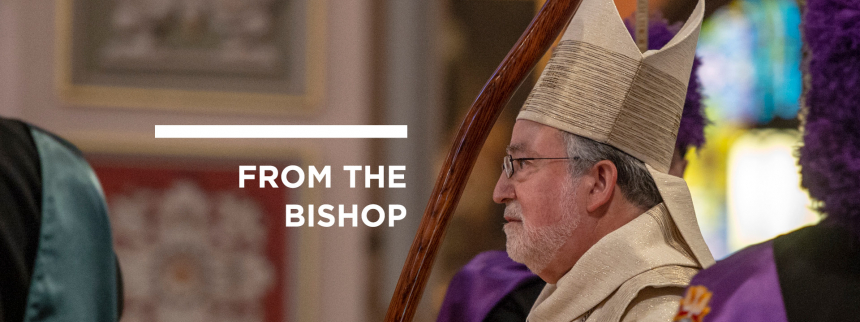
During my early years as a priest in the 1980s and 90s, I served a number of years in the city of Santa Ana. During that time, the city underwent dramatic demographic changes. Like most of Orange County, Santa Ana had once been dedicated mostly to agriculture. True to the county’s name, many citrus groves – mostly orange groves – thrived in the area. The older towns – Anaheim, Fullerton, Orange and Santa Ana – had packing houses for sorting, storing and shipping citrus as well as other local produce. The emergence of the aerospace industry and the arrival of Disneyland ushered in a new economy.
In the northwest corner of Santa Ana there stood an abandoned and decrepit sugar beet processing plant. As a young teenager, I frequently drove between the old plant and the enormous World War II dirigible hangers at the Tustin Air Base on my way to and from the beach. They were silent reminders of the past that was slowly moved aside by amusement parks, industrial parks, hotels, freeways and shopping malls.
I was assigned to a parish near the old sugar beet plant, Our Lady of Guadalupe, where I served for 13 years. The parish was established to care for the farmworker community – mostly Mexican immigrants – living on what was once the outskirts of Santa Ana. By the time I was assigned, there were already plans to tear down the plant to make room for hotels for the increasingly bustling Orange County Airport, later named after a well-known local resident, John Wayne.
In the 1970s, the immigrant community began to burgeon, filling jobs in the growing number of assembly plants, hotels, residential and commercial construction companies, and restaurants that were replacing the once verdant agricultural fields. Many immigrants found a home in Santa Ana. The eight Catholic churches in the city became more than spiritual havens; they were also the social hubs for finding a sense of belonging in the new unfamiliar world of Southern California. Most of the immigrants were young, leaving their families and villages in Mexico and Central America, and traveling north alone. The parishes of Santa Ana offered a healthy refuge from other less wholesome social activities in the area.
Indicative of the shifting demographics was the number of children being baptized. Almost half of the baptisms in the Diocese of Orange were celebrated in the eight parishes of Santa Ana. So many, that the baptism ceremonies were conducted weekly. To manage the numbers, pastors put limits on the number of children to be baptized, with 25 or 30 as a weekly average.
Young people and young families frequented the parishes looking for friends from back home or seeking to make new friends. I recall some of the older matrons of my parish shaking their heads at the number of young people squeezing into the Sunday evening Mass. They sniped, “The boys are only looking for girlfriends.” I said, “Better here, than in the cantinas on Fourth Street.” They reluctantly agreed.
Religious education programs were also large. At Guadalupe parish, a devoted volunteer coordinator managed a program for 700 or more children. First Communions every year averaged between 400 and 500 students. The church had a capacity for 250 people. There was a small hall and four classrooms. Given the limited space and the number of other activities beside religious instruction, there was always something going on.
The joy of living in this vibrant hive of humanity was found in the recognition that the parishes were a vital part of the neighborhoods surrounding them. The feasts, festivals and parish carnivals were community events that brought in the neighbors as well as active parishioners. After Sunday Masses, the hall offered a variety of traditional Mexican foods. During my weekly portion of menudo, I often noticed families whom I had not seen in the church. They were a little uncomfortable when the priest would come to sit with them.
Many parishes in the Diocese of Sacramento have the same or similar vitality. All of which is a reminder of how integral to any parish are the programs that ensure our churches and schools are safe havens for children and young people. Background checks, trainings, and other safe environment protocols promote an appreciation among everyone about how precious and privileged the places are where God’s people gather. It is the essential duty of true hospitality.
The weekly baptism ceremonies in Santa Ana were sacramental rituals surrounded by a cacophony of crying children, restless families and a buzzing swarm of cameras. In the middle of this barely managed chaos, came the moment when the parents, godparents and other family members huddled around the baptismal font with the priest. Depending on the temperament of the unsuspecting child, glances went back and forth between the parents and godparents wondering who would hold the squiggly baby. The minister then solemnly asked, “Is it your will that – José or Lucia or Carmen or Eduardo – should be baptized in the faith of the Church, which we have all professed with you?” Without hesitation the family said, “yes.” Then all nudged even closer and leaned over the font as the sacred waters were poured on the tender infant’s head.
In that holy, happy moment during every baptism, a pledge is made by priest, parents and community to keep this child safe in our hands and in the hands of God until the day we all come before the judgment seat of Jesus, our Lord.

